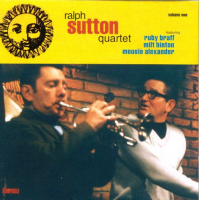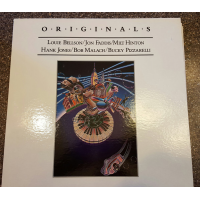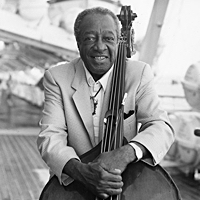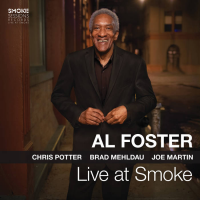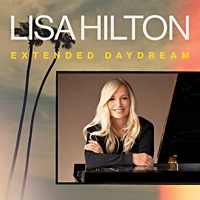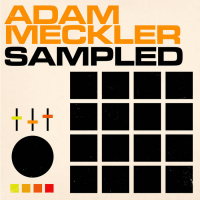Home » Jazz Musicians » Milt Hinton
Milt Hinton
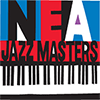
"The Judge"
Milt Hinton was widely regarded as the dean of jazz bassists. This master bassist was one of the consummate sidemen in jazz history. His career very nearly spanned the gamut of jazz generations and he was one of those rare musicians who exhibited minimal ego and had an ability to make a contribution to any setting he found himself in, no matter the style. He once said, according to the New York Times, that he had made "more records than anybody," and at the peak of his recording career he kept instruments at each of several major recording studios so that he would be ready to play at a moment's notice.
Like so many African American families in the early part of the 20th century, his family migrated from Mississippi north to Chicago, where he was raised. His mother was a church musician, playing organ, piano, and directing the choir. She bought him a violin for his thirteenth birthday, which he studied for four years from 1923-27. Later he picked up the sarousaphone, bass horn, and tuba and studied music at Wendell Phillips High School in Chicago. In 1928 he found his voice when he switched to string bass. One of his earliest professional affiliations was with violinist Eddie South, with whom he played intermittently between 1931-36. Other of his early affiliations were with Zutty Singleton, Johnny Long, Tiny Parham, Erskine Tate, Art Tatum, Cassino Simpson, and Jabbo Smith.
One of the longest of his early band jobs was with the Cab Calloway band, where he worked from 1936-51. This would be his most extended sideman gig as thereafter he was the ultimate freelance musician. After leaving Calloway he worked with Joe Bushkin, comedian Jackie Gleason, and Phil Moore before joining the Count Basie band for two months. He played with Louis Armstrong between 1952- 55, then became a staff musician for CBS, one of the first African American musicians welcomed into the TV studios. From 1956 on Milt was a much in-demand studio musician. He made club gigs with such musicians as Jimmy McPartland, Benny Goodman, concerts with Ben Webster, Sammy Davis, Jr., Judy Garland, and Harry Belafonte among many others. In the 1960s he became a staff musician at ABC, where he worked on the Dick Cavett Show.
He worked at a feverish pace through the '60s and '70s, appearing on recordings ranging from television commercial jingles to those by such artists as Mahalia Jackson, Barbra Streisand, Dinah Shore, Debbie Reynolds, Johnny Mathis, and a young Aretha Franklin in the pre-soul stage of her career. Accounts differ as to how Hinton acquired his lasting nickname of "The Judge," but one theory holds that it came about because he insisted on absolute punctuality from the musicians with whom he worked.
Read moreTags
April PBS Special Honors Life, Music and Photos of Milt Hinton

by Chris M. Slawecki
You don't have to be a great person to be a great musician. It's great if and when it happens, but it seems that it rarely does.
Milt Hinton seems a joyous exception to this rule. By all accounts a great person AND musician, he is celebrated with the new documentary Keeping Time: The Life, Music and Photographs of Milt Hinton, scheduled for April 12 broadcast on most PBS television stations as part of Independent Lens' April Music ...
Continue ReadingMilt Hinton: The Basement Tapes

by Riel Lazarus
In recent years, much of the attention given to late bass great Milt Hinton's career and legacy has been directed at his prowess as a jazz photographer. Nevertheless, we must not forget that behind those extraordinary photographs was an equally extraordinary musician. With Chiaroscuro's recent release of The Basement Tapes, jazz fans will find a welcome reaffirmation of Hinton's formidable gifts as both timekeeper and soloist. Composed of previously shelved material, the disc's 14 tracks offer up ...
Continue ReadingMilt Hinton & Friends: Old Man Time

by Mike Neely
Anyone who listens seriously to jazz has heard Milt Hinton’s solid, earthy bass. The number of early jazz, swing, and swing- influenced recordings Hinton has played on must be in thousands. This grand master of the instrument died this past December after a long, distinguished career. Back in 1990, Chiaroscuro Records released a double CD entitled Old Man Time as a tribute to Mr. Hinton on his 80th birthday. It’s time to revisit this recording not only for the music ...
Continue ReadingThe Milt Hinton Institute For Studio Bass At NJPAC, In Residence At Montclair State University, Welcomes Young Musicians To A Summer Of Extraordinary Learning And Discovery

Source:
AMT Public Relations
Student bassists invited to apply for July 2024 music and performance camp focused solely on their instrument The New Jersey Performing Arts Center (NJPAC) will host the Milt Hinton Institute for Studio Bass, an exceptional summer music education program for teens, in residence at Montclair State University, in July 2024. Unique among music camps, the Hinton Institute is designed to support intermediate and advanced bass players ages 14 through 18, for a week of expert classes, performances, ensemble work, studio ...
read more
Music Education Monday: Still all about that bass (with Ray Brown and Milt Hinton)

Source:
St. Louis Jazz Notes by Dean Minderman
As yr. humble editor is not one to leave any good material unused, or any bad pun or pop culture reference unmade - at least of couple times - today's “Music Education Monday" post is a sequel to last December's “All About That Bass", featuring a few more bass-related links and video clips that turned up during the info-gathering for that post. Keeping in mind that the general criteria here is “music instructional materials available for free on the internet," ...
read more
Tribute To Bass Legend Milt Hinton This Week On Riverwalk Jazz

Source:
Don Mopsick
This week, Riverwalk Jazz presents a legacy broadcast featuring the iconic bassist Milt Hinton in a 1991 performance with The Jim Cullum Jazz Band, live at The Landing in San Antoniio. Milt was 81. Milt Hinton used to say, “A person has to have lived to play great jazz…Unless you’ve lived, what could you say on your instrument?” Milt Hinton had plenty to say in his thousands of recordings, with his lively storytelling, and in some 60,000 black and white ...
read more
Playing the Changes: New Book and CD Chronicle the Artistic and Personal Journey of Milt Hinton

Source:
Carolyn McClair Public Relations
The Words, Images, and Music of One of the Greats In American Jazz New book and cd chronicle the artistic and personal journey of extraordinary bassist Milt Hinton The life story of Milt Hinton is rooted in hard times, rising from segregated backwater clubs to elegant concert halls, offering a perspective on the African American experience that is unique in its mix of humor and wisdom. The publication of PLAYING THE CHANGES: Milt Hinton's Life in Stories and Photographs (Vanderbilt ...
read more
Memphis' Stax Museum Hosts Jazz Photography Exhibit by Bassist Milt Hinton

Source:
Stax Museum of American Soul Music
Fifty Intimate Photos Portray Behind the Scenes View of Jazz World
When Billie Holiday entered the recording studio in New York City in the spring of 1959, the glass of vodka she sipped didn't help her voice the way she thought it would. The session didn't go well. In fact, it would be the last recording session of her acclaimed life, which ended tragically later that year on July 17th. What was also recorded that day was her session on ...
read more
"Keeping Time: The Life, Music and Photographs of Milt Hinton" Airing on PBS in April

Source:
All About Jazz
Jazz Bassist and Historian Milt Hinton Dies at 90.

Source:
All About Jazz
We sadly note the passing of Milt “Judge" Hinton on Tuesday, December 19. Hinton died at a hospital in Queens, NY after an extended battle with Parkinson's disease.
During his distinguished 70-year career, Hinton performed with almost every luminary of jazz and popular music, from Louis Armstrong, Cab Calloway, Dizzy Gillespie and John Coltrane to Bing Crosby, Frank Sinatra, Barbra Streisand and Paul McCartney. He is one of the most-recorded musicians in the history of the business.
Hinton also documented ...
read more








